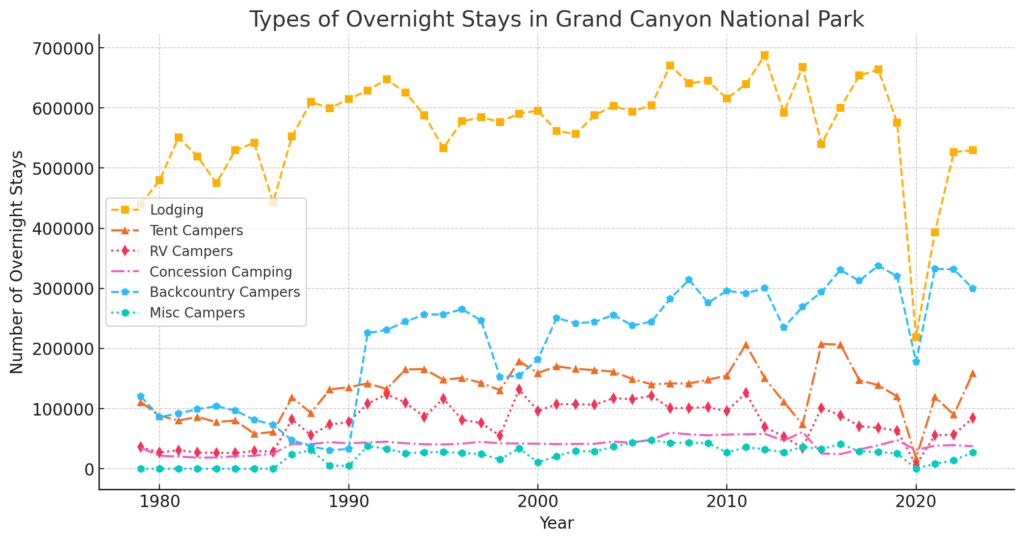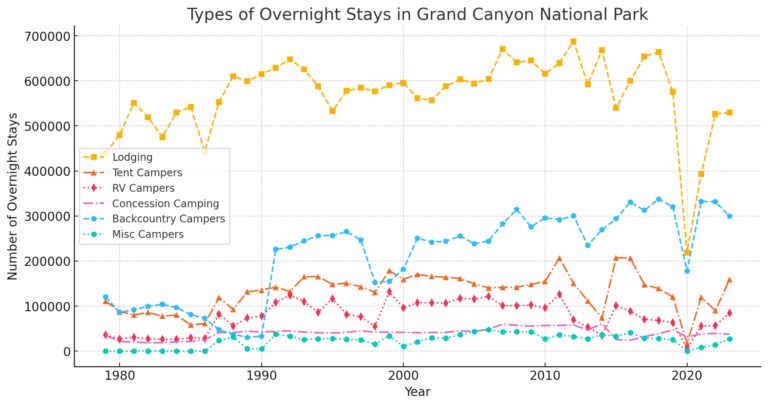For decades, Grand Canyon National Park has been one of the most visited natural wonders in the United States, attracting millions of tourists each year. Beyond the breathtaking landscapes, a crucial aspect of tourism in the park is how visitors choose to stay overnight. The analysis of long-term data on overnight stays provides insights into changing visitor preferences, infrastructure developments, and external factors such as economic shifts and the COVID-19 pandemic.
Methodology and Data Collection
This study is based on extensive historical data spanning multiple decades, incorporating both quantitative and qualitative sources. The primary dataset consists of National Park Service visitor records, supplemented by surveys, economic reports, and environmental assessments. Statistical methods such as time-series analysis and regression modeling were applied to detect trends and identify causal relationships.

Long-Term Trends in Overnight Stays
An extensive analysis of historical data from the late 1970s to the present reveals a steady increase in overnight stays across various accommodation types. However, this growth has not been uniform, with some categories experiencing more pronounced fluctuations than others.
1. Lodging: The Dominant Choice
Lodging facilities, including hotels and lodges, have consistently been the most preferred option for overnight stays in the Grand Canyon. In the early years of the dataset, the number of lodging stays was relatively low compared to recent decades. However, as infrastructure improved and demand increased, the number of people staying in lodges has more than doubled.
Several factors contributed to this trend:
- Increased availability of lodging facilities: The expansion of park-operated and private hotels within and near the park has facilitated higher capacity.
- Rising visitor numbers: More tourists naturally translate into greater demand for structured accommodations.
- Preference for comfort: A shift in tourist demographics toward older travelers and families has resulted in a preference for lodges over camping.
Interestingly, while lodging remains the dominant form of accommodation, its growth has shown periodic stagnation, particularly during economic downturns and travel disruptions such as the 2008 financial crisis and the COVID-19 pandemic in 2020.
2. The Rise and Fluctuations of Tent Camping
Camping, particularly tent camping, has exhibited a fluctuating yet resilient pattern over the years. Unlike lodging, which saw relatively linear growth, tent camping numbers have experienced more variation, influenced by factors such as:
- Weather patterns: Harsh summer conditions with extreme heat waves have deterred some visitors from choosing tent camping during peak months.
- Reservation requirements: Changes in booking systems and increased restrictions in certain areas of the park have impacted accessibility.
- Changing travel trends: While some years saw increased interest in budget-friendly and outdoor-focused travel, other periods, such as the rise of glamping (luxury camping), may have drawn some visitors away from traditional tent camping.
Despite these fluctuations, tent camping has maintained its popularity, particularly among younger visitors and those seeking a more immersive nature experience.
3. The Steady Growth of RV Camping
Recreational vehicle (RV) camping has seen a steady increase over the decades, reflecting broader trends in road trip culture and increased ownership of RVs in the United States. RV camping appeals to a unique segment of visitors who prioritize mobility, flexibility, and a balance between comfort and an outdoor experience.
The growth in RV camping can be attributed to:
- Advancements in RV technology: Modern RVs offer greater comfort, making long-term travel more viable.
- Expansion of campgrounds: The Grand Canyon has improved RV camping facilities to accommodate growing demand.
- Retiree travel boom: A significant portion of RV campers consists of retirees engaging in cross-country travel, a demographic that has expanded with the aging baby boomer population.
4. The Niche but Rising Popularity of Backcountry Camping
Backcountry camping, which involves wilderness stays requiring permits, has remained a relatively niche category but has seen steady growth over time. Unlike front-country camping (tent and RV camping in designated areas), backcountry camping appeals to adventure enthusiasts and those seeking solitude. The increase in backcountry camping can be linked to:
- Greater awareness and interest in wilderness exploration
- Efforts to promote sustainable, low-impact travel
- Improvements in lightweight camping gear making backcountry travel more accessible
However, the growth in backcountry camping has been tempered by strict regulations aimed at protecting fragile ecosystems and preventing overcrowding.
The Impact of External Events on Overnight Stays
The COVID-19 Pandemic and Its Impact on Tourism in Grand Canyon National Park
The COVID-19 pandemic had an unprecedented impact on tourism worldwide, and Grand Canyon National Park was no exception. The park saw one of the most dramatic declines in visitor numbers in its history as travel restrictions, lockdown measures, and public health concerns forced national parks to close or operate at limited capacity.
1. Park Closures and Restricted Access In March 2020, Grand Canyon National Park was temporarily closed to visitors to mitigate the spread of the virus. The closure, which lasted for several months, led to a near-total collapse in tourism-dependent activities. Even after reopening, restrictions on capacity, social distancing measures, and the temporary suspension of certain services continued to suppress visitor numbers.
2. Sharp Decline in Overnight Stays
- Lodging: Hotel and lodge occupancy rates plummeted due to public health concerns and reduced capacity limits.
- Tent Camping & Backcountry Camping: Initially, a decline was observed due to travel restrictions, but once domestic travel picked up, camping rebounded faster than other accommodation types as travelers sought socially distanced outdoor activities.
- RV Camping: This category saw a rapid increase in demand as travelers opted for self-contained accommodations that minimized interactions with others.
3. Economic Consequences The sudden drop in visitation had severe financial repercussions for businesses reliant on park tourism, including hotels, tour operators, and restaurants in nearby communities. Many businesses reported revenue losses exceeding 50% during the peak of the crisis. Federal relief programs provided some support, but long-term economic damage remained a concern for many local businesses.
4. The Post-Pandemic Recovery By mid-to-late 2021, a strong recovery was underway. Domestic tourism surged as travel restrictions eased, and visitors, eager for outdoor experiences, flocked back to the Grand Canyon.
- RV and backcountry camping saw higher-than-usual demand as travelers preferred isolated and self-sufficient accommodations.
- Lodging numbers rebounded but remained below pre-pandemic levels due to lingering international travel restrictions.
- Online reservation systems and digital park access permits became more widespread as part of a broader shift toward contactless tourism management.
The long-term effects of the pandemic on tourism habits remain to be seen, but early indicators suggest that interest in socially distanced, nature-based travel has increased, which may shape visitor preferences at the Grand Canyon for years to come.
Statistical Analysis and Predictive Modeling
Using regression analysis, predictive models indicate that overnight stays are likely to continue increasing, though at different rates for each accommodation type. The elasticity of demand varies between lodging and camping options, with lodging exhibiting greater stability and backcountry camping showing higher volatility.
Looking Ahead: The Future of Overnight Stays
Based on historical patterns and emerging trends, several predictions can be made about the future of overnight stays in the Grand Canyon:
- Lodging will continue to dominate, but sustainability concerns may drive eco-friendly accommodations and stricter visitor caps.
- RV camping will remain strong, particularly among retirees and digital nomads who favor mobile lifestyles.
- Backcountry camping will see controlled growth, limited by conservation efforts and permit regulations.
- New accommodation models may emerge, such as glamping and hybrid camping-lodge options catering to comfort-seeking travelers who still want an outdoor experience.
